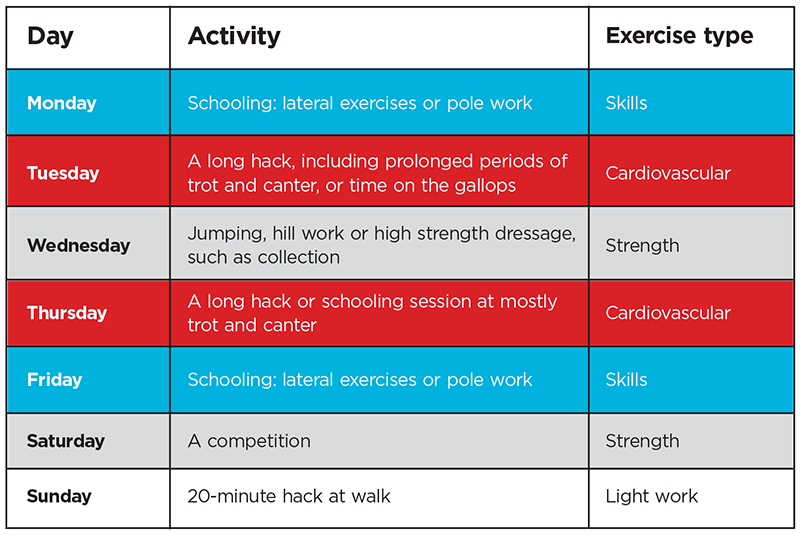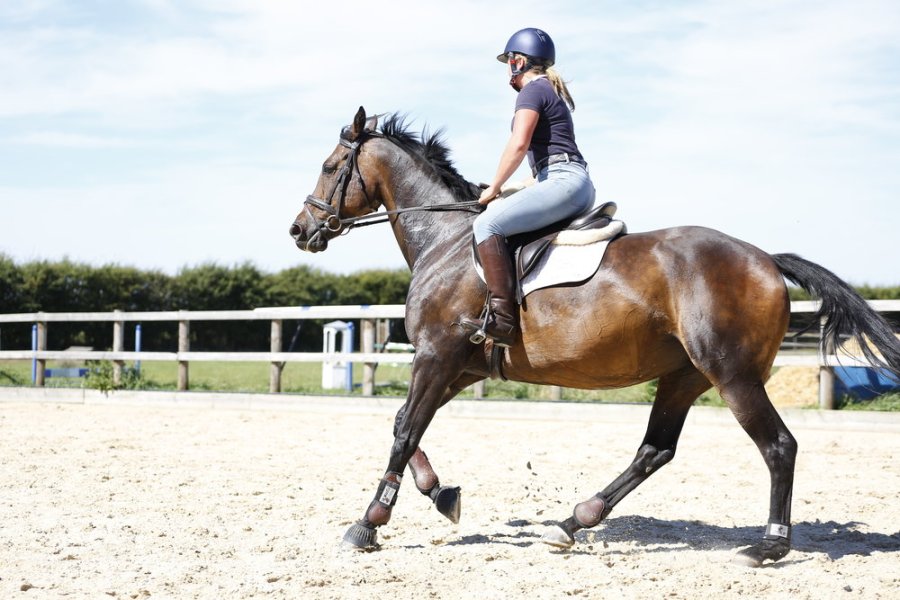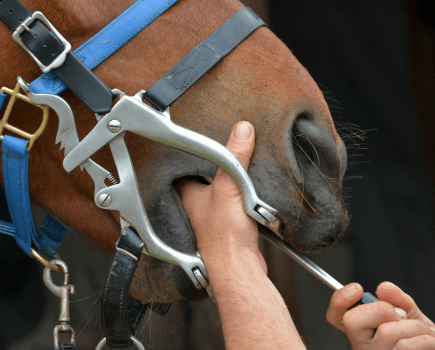A fitness plan is an important part of taking care of a horse, because when they are fit they not only perform better, but they are more likely to enjoy it, stay sound and have a longer and more active life.
For any horse to perform well, whether competing, hacking out or riding at home, they have to be physically capable of doing the task you’re asking. Different breeds and types are more suited to either sprint or endurance-type sports, depending on their conformation and inherited muscle fibre composition.
Benefits of a horse fitness plan
A well-designed and carefully planned conditioning fitness plan will help to strengthen a horse’s ligaments, tendons, bones, joints and muscles. This will help to help to avoid injury (although a small risk will always remain), while also developing the horse’s cardiovascular system.
“To get a horse fit, you gradually increase the physical stress on their body so that their response to it improves. How fit they need to be depends on what you’re planning to do,” says former five-star event rider Marie Ryan, whose horse Penny Royal II finished best mare at Badminton for two consecutive years.
“A basic level of fitness should enable a horse to compete happily in low-level dressage, showjumping and one-day events as well as hacking and schooling. Anything more demanding will require a higher level of fitness.”
Fitness timescale
The time it takes to achieve a basic fitness level varies according to your horse’s age, type or breeding, and how fit they have been in the recent past.
“A young horse who’s been backed and ridden on for a year, but is now ready to be got properly fit for the first time, will need longer than an older horse who has been kept ticking over during the winter and is now being prepared for a competitive spring season,” explains Marie.
“As a general rule, cold-blooded horses such as cobs and those with a higher percentage of draught blood often take longer to get fit than the hot-blooded Thoroughbred and Arab types. Warmbloods take less time than cold bloods, but slightly more than hot-blooded horses.”
Creating a fitness plan
To create a fitness plan for a fit and strong horse you’ll need to combine schooling and jumping with hacking. Plus, you’ll need to allow time for them to recover between sessions. Different types of training can be categorised as:
Cardiovascular training
Cardiovascular training uses trot, canter or gallop for periods of at least 20 minutes, depending on your horse’s fitness.
Skills training
Skills training means riding lateral work or doing pole work, for example.
Strength training
Strength training is jumping, hill work and exercises which require your horse to work in collection, such as piaffe.
Your horse’s muscles are most at risk during strength training. So, to help prevent injury, you need to gradually increase the intensity of this type of work.
The plan below is a rough guide from Marie explaining what to do with your horse and when. As a general rule, allow at least two days between strength training sessions to give your horse’s muscles time to repair.
Remember, you know your horse best, so listen and focus on how they’re feeling. Don’t do too much too soon.

Fitness plan: preparing the horse
Marie stresses the importance of it being the rider’s job to ensure the horse is fully prepared for what we are asking them to do. She uses the following schedule when training her horses:
1 Health check
Before starting any work, give your horse a full health MOT.
“Check their teeth are not causing any discomfort and I’d also advise getting their back and saddle checked by someone qualified,” advises Marie.
2 Begin the ‘LSD’
This is long, slow, distance work and it is usually done out hacking.
“Depending on your horse’s starting fitness point, you ideally need to spend two to four weeks in walk, gradually building up the time,” says Marie. “Start off doing half an hour, building up to one to 1.5 hours per day.”
3 Quality, not quantity
Aim for quality work over quantity. Your horse’s walk should be active and rhythmical. Even if they aren’t truly on the bit, at least have them working towards it, with a pliable contact for them to work into so that they begin to build the correct muscles.
4 Start schooling
“Over the next four weeks, introduce arena work, riding large figures such as figures of eights, 20m circles, three-loop serpentines, changes of diagonal,” advises Marie.
“Leg-yield and shoulder-in adds variety and builds suppleness.”
5 Go steady
Remember to start slowly. A schooling session is usually more strenuous than a steady hack in a straight line. Start with 15 minutes of schooling and gradually build up to 30 minutes and 45 minutes.
“Start small periods of trot, both out hacking and in the school,” suggests Marie. “It should be an easy, rhythmical working trot, starting with short bursts and slowly increasing.
6 Hill work
Find some hills and introduce gentle hill work (read more about this below). If you live in a flat area, introduce interval training to compensate for the lack of hills.
7 Lunging
Lunging a horse counts towards fitness too.
“Keep the circles large at first, starting with five minute sessions and building up to 10,” states Marie. “Using a lunging aid, improvements can be made to self-carriage, obedience to the voice and engagement.
“Lunging is also particularly useful if you’re short on time.”
8 Introduce canter
If all is going well, introduce short bursts of canter on good ground.
“Ensure the canter is balanced and rhythmical so your horse is working correctly and building the right muscles,” adds Marie. “Work in straight lines to start with and don’t forget transitions.”
9 Get your entries in
After three or four weeks of canter, most horses will be ready for a dressage competition or perhaps a fun ride. Factor in the travelling, warming up and time waiting around — it all requires energy.
10 Increase the effort
The final stage, according to Marie, is to increase the duration of work and how much effort the horse has to put in.
Schooling sessions (three to four per week) become more frequent and demanding. Hacks become longer with longer bursts of trot and canter. Polework and jumping can also be introduced.
Horse fitness plan: variety is key
When getting her event horses fit, two-time Badminton CCI5* winner Pippa Funnell believes in spending as much time out of the school as possible and varying their fitness programme.
“I do lots of hacking and am fortunate to have access to some lovely fields with testing terrain which is wonderful,” she says. “I love riding on different surfaces and cambers because eventing is about that. One minute you’re on sand, the next in mud — it’s not just about being on pristine gallops.”
Double Olympic eventing champion Mark Todd is fortunate to have plenty of safe hacking near his Marlborough base. He’s retired from eventing now, but it came in useful when getting myriad horses fit.
“I did roadwork to build up fitness before going into the school, but I know roads can be tricky if you’re in a busy area,” says Mark. “Be creative and see what you have available; you don’t need an arena, you can do fitness work in a field.”
Walking is really good for your horse’s heart and lungs. It doesn’t have to be dull. Even if you’re hacking, use the time doing light suppling exercises such as shoulder-in. You can also work on riding transitions from medium walk to free walk on a long rein and back to medium walk.
If you’re doing walk work in an arena, do lots of stretch work, ride lots of big circles and plenty of changes of rein. Use this time to get your horse soft and swinging through his back.
Roadwork
According to Dr David Marlin, roadwork subjects a horse’s hoof to forces 20 times greater than a good grass or arena surface. He also states that trotting on the road doesn’t harden or strengthen tendons. Roadwork does increase bone strength, but you only need a few minutes of trot to achieve this.
“Walking is fine and shouldn’t be limited. Trotting should be limited to no more than five minutes a day,” he advises. “The best advice for keeping horses sound is to work them on varying surfaces, including good grass, arenas and roads.”
Read more from Dr David Marlin here.
Hillwork
Hill work is an important element of every horse’s fitness plan, because it means you can train with low impact and high intensity.
Walking uphill engages your horse’s hindquarters. The steeper the hill, the harder they have to work. Done correctly, it can be just as valuable as fast work as your horse has to concentrate on their balance.
Increasing the gradient increases your horse’s energy output, but bear in mind that the more impulsion you create as you go uphill, the more stress there is through the hind limbs.
Hill work will also develop your horse’s hindquarters and shoulder muscles, and can improve their topline.
“Hillwork is something that you can build up gradually,” explains event rider Ibby Macpherson. “I like to incorporate it into my hacks and also after some schooling.
“For example, if I’m looking to improve my horse’s fitness, I might school for a bit and then canter up a hill. Start gradually and work your way up. Once your horse is feeling fitter, you can always increase the number of times you canter up the hill.”
How to utilise hills
- Your horse must be suitably warmed up before tackling steep climbs or upping the pace, in the same way a human athlete shouldn’t run straight out of their house and up a steep hill.
- To begin with, use your common sense and be guided by your horse. If they are panting hard, you’ve done too much, too soon.
- Bear in mind that walking uphill, in balance, is as valuable as doing fast work up hills. Slow work also lessens the likelihood of injury to your horse’s tendons and ligaments.
- When riding uphill in trot, it’s a good idea to occasionally allow your horse to stretch forward and reach into their stride as they work through from behind.
- Ride in a light, balanced seat going uphill to help your horse use their back.
- Introduce transitions as you’re going up and down hill, as these will help to improve your horse’s balance.
- As your horse becomes fitter and you feel they are ready, try trotting up and down the hill, and then progress eventually to canter. Including different transitions will flex your horse’s brain, as well as their muscles!
Horse fitness plan: interval training
Incorporating interval training into your horse’s exercise regime can be beneficial for building their fitness, as well as maintaining it. Interval training also offers variety in a horse fitness plan, as it is fun and interesting to do.
“Interval training’s about varying the pace which you can do in a field or in a small area, like a 20x40m arena,” explains Pippa Funnell.
“Shorten your stirrups, get out of the saddle and imagine you’re going cross-country down the long side, then sit up and collect the horse down the short side. Remember to change the rein. Building little jumps into interval training helps fitness too.”
Pippa recommends learning to ride by feel when interval training, rather than looking at a stopwatch.
“Don’t only look at your watch when interval training; get into the habit of feeling how the horse is going and how quick his recovery is. Go on the soft side and slowly build up,” she says.
Sample interval plan
Interval training is a great way to build up your horse’s heart rate. Use ‘Set 1’, below, for one or two weeks in the earlier stages of your fitness plan before your horse is ready for some more intense work. Then move on to ‘Set 2’.
Interval training: set 1
- Ride in a brisk trot, on good ground in three intervals of six minutes with a walk break in-between.
- As your horse’s fitness and consequent recovery rate improves, up your intervals to four minutes.
- Make sure your horse is working in a good, forward rhythm and that he’s straight.
- Change the diagonal every so often too.
Interval training: set 2
When your horse is ready to work that little bit harder, try using this second set as part of your fitness plan, maintaining a good rhythm in each pace:
- 20 minutes: Walk
- 10 minutes: Brisk trot
- 5 minutes: Walk
- 2 sets of 3 minutes (3 minutes of walk in-between): Forward canter
Some horses respond better to sprint work that opens their pipes rather than long intervals of strong and steady canter. On these horses, ride short bursts of fast canter instead.
Things to watch for
While getting a horse fit, it’s vital to keep an eye on their overall health and soundness at every stage.
Make sure you:
- Check shoes daily for any risen clenches, lost of twisted shoes, and abnormal wear.
- Examine your horse’s legs every day so that you build an awareness of what’s normal for them and what’s not. You’re more likely to detect any heat or swelling early.
- Check for any rubs or sores around the horse’s mouth, girth area, on the legs, and where the saddle and bridle sits.
- Regularly check the fit of your saddle. As horses get fitter, their shape often changes.
- Take care to ride at an appropriate speed for the ground conditions you’re riding on. Inconsistency in the ground — soft to hard, hard to soft, for example — can cause strains and other injuries.
- Monitor your horse’s recovery rate after work and whether they’re feeling suitably energised for the work required of them.
- Don’t over-exercise the day before a competition. Fitness needs to be built up in the weeks and months beforehand.
“If possible, it’s better to exercise the day before for two short periods rather than taking a horse for a fast, two-hour hack, which may leave the horse sore,” advises Marie Ryan.
Feeding for fitness
Remember, how and what you fuel your horse with is a key part of a good fitness plan too. As your horse’s workload increases, they may need additional energy from their diet.
Speak to a nutritionist who will be able to advise you on your individual horse’s requirements. Any adjustment or introduction to feed should be done gradually over a number of days.
Here are some key feeding rules to help you keep your horse fit from the inside out:
- Pick the right feed for your horse’s job.
- Only feed for the work your horse does and don’t increase feed unnecessarily.
- Always introduce new feeds gradually.
- Consider supplements, such as electrolytes, when your horse’s is working hard and competing.
- Speak to an equine nutritionist if you’re in doubt about your horse’s diet.








